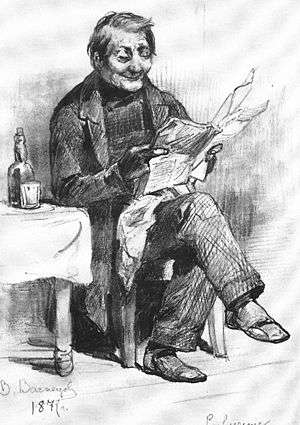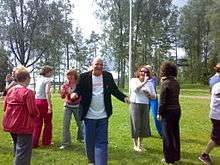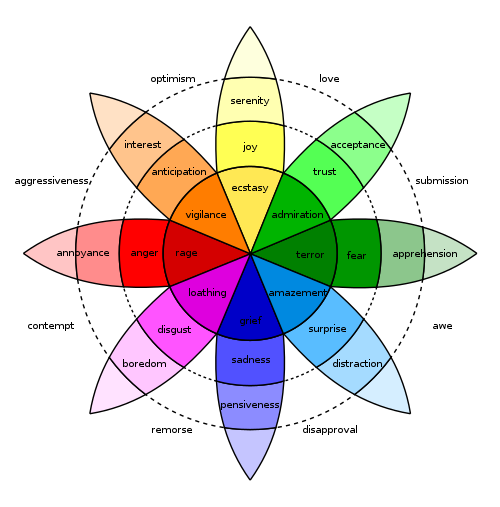Amusement
Amusement, from the old French à muser – to put into a stupid stare,[1] is the state of experiencing humorous and entertaining events or situations while the person or animal actively maintains the experience, and is associated with enjoyment, happiness, laughter and pleasure. It is an emotion with positive valence and high physiological arousal.

Amusement is considered an "epistemological" emotion because humor occurs when one experiences a cognitive shift from one knowledge structure about a target to another, such as hearing the punchline of a joke.[2] The pleasant surprise that happens from learning this new information leads to a state of amusement which people often express through smiling, laughter or chuckling.
Current studies have not yet reached consensus on the exact purpose of amusement, though theories have been advanced in the fields of psychology, psychiatry and sociology. In addition, the precise mechanism that causes a given element (image, sound, behavior, etc.) to be perceived as more or less 'amusing' than another, similar element to a particular individual is not clearly understood.
Theories
Two different theoretical perspectives about emotion provide contrasting origins of amusement:
Evolutionary
The evolutionary perspective proposes that amusement is a distinct emotion that evolved to enhance a species’ survival. Collective laughter helps define an ingroup, helping people recognize those similar to them and feel included.[3][4] It also helps identify outgroup members and enhance the barrier between the two. Laughter can provide network support as encouragement, or it can inform ingroup members that they are losing majority favor and to adjust their behavior to reassimilate.[5]
Constructed emotion
The theory of constructed emotion suggests that when humans have a positive experience that increases their arousal, such as a faster heartbeat and increased sweat production, they cognitively seek out a label for that feeling. They will land on amusement if that experience resembles other amusement experiences they have had.[6][7]
Emotional expression of amusement
The origin of the study of emotional expression is often attributed to Charles Darwin.[8] In 1872, Darwin published his book The Expression of the Emotions in Man and Animals, in which he extensively describes his observations of how people and animals display emotions on their faces and through sound.[9] Darwin comments on amusement as an emotion of great joy during which a person is likely to laugh. He also notes that across all peoples humans can laugh until they are panting and tears roll down their cheeks. In the 1960s, Paul Ekman, an American psychologist, revived the study of emotional expression, proposing, like Darwin, that emotions were universally recognizable.[10] His early work focused on six basic emotions: happiness, anger, sadness, fear, disgust and surprise.[11] By the 1990s, Ekman had expanded this list to include several additional emotions, one of which was amusement.[12]
Displays of amusement have been distinguished from related emotions like embarrassment and shame.[13] More recent studies have confirmed that laughter is a distinct signal of amusement and is recognizable across cultures.[14][15][16]

Facial expression
An amused facial expression typically has these characteristics:[17]
- Head: Thrown back with jaw lifted
- Eyes: Crow's feet at the eyes indicating that the muscles have tightened
- Mouth: Open, jaw dropped with relaxed muscles
Vocal burst
The expression of amusement is usually accompanied by genuine laughter. The experience of laughter changes the breathing pattern and often causes all the muscles to relax.[17]
Cultural considerations
As a positive, high arousal emotion, amusement falls in the same category as excitement and exhilaration. These emotions are highly valued in American culture where positive feelings that high in energy are seen as ideal. In contrast, East Asian cultures value positive, low arousal emotions such as contentment, calm and peacefulness.[18]
Clinical uses
Emotion regulation
Emotion regulation is the term for how people attempt to influence - increasing, decreasing, maintaining or changing - how, when, and where they experience emotion.[19] Through changing how they think about a target of amusement, like a humorous video clip, people are able to increase and decrease how much amusement they feel, express in smiles and laughs, and experience in their bodies (e.g. increased heart rate and respiration).[20] Choosing to increase or prolong experiences of positive emotion is one way in which people can learn to cope when faced with challenges and develop resilience.[21]
Resilience
As a positive emotion, amusement contributes to the development of resilience in both children[22] and adults.[23] Positive emotions help people build social resources that foster their ability to cope during hard times.[24] Increases in resilience lead to higher life satisfaction and general happiness.[25]

Laughter therapy
Rapidly growing in popularity, laughter therapy, or humor therapy, focuses on promoting laughter as a therapeutic tool.[26] Usually implemented in a group, laughter therapy uses a variety of gag jokes like red noses and magic tricks to encourage laughter - fake or real. Laughter causes the bodies' muscles to relax which increases blood flow and oxygen intake.[27] Proposed benefits include: Stress management,[28] relaxation, improved mental functions, improved digestion and pain relief. Some suggest that laughter activates similar brain wave frequencies as a meditative state.[29] However, scientific studies of these benefits are limited and have methodological issues.[30]
See also
References
- "Amuse, v." Oxford English Dictionary. Retrieved 21 November 2017.
- Shiota, M. N., Keltner, D., & John, O. P. (2006). "Positive emotion dispositions differentially associated with Big Five personality and attachment style". The Journal of Positive Psychology. 1 (2): 61–71. CiteSeerX 10.1.1.421.1730. doi:10.1080/17439760500510833.CS1 maint: multiple names: authors list (link)
- Shiota, M. N., Campos, B., Keltner, D., & Hertenstein, M. J. (2004). Positive emotion and the regulation of interpersonal relationships in The Regulation of Emotion. Mahwah, NJ: Philippot, P. & Feldman, R. S. Eds. Lawrence Erlbaum Associates Inc. pp. 127–155.CS1 maint: multiple names: authors list (link)
- Latta, R. L. (1999). The basic humor process: A cognitive-shift theory and the case against incongruity. New York, NY: Mouton de Gruyter.
- Coser, Rose Laub (1 April 2016). "Some Social Functions of Laughter". Human Relations. 12 (2): 171–182. doi:10.1177/001872675901200205.
- Barrett, L. F. (2006). "Solving the emotion paradox: Categorization and the experience of emotion". Personality and Social Psychology Review. 10 (1): 20–46. CiteSeerX 10.1.1.577.4057. doi:10.1207/s15327957pspr1001_2. PMID 16430327.
- Barrett, L. F. (2017). "The theory of constructed emotion: an active inference account of interoception and categorization". Social Cognitive and Affective Neuroscience. 12 (1): 1–23. doi:10.1093/scan/nsw154. PMC 5390700. PMID 27798257.
- Keltner, D., Tracy, J. L., Sauter, D. A., Cordaro, D. C. & McNeil, G. (2016). "Expression of Emotion". In Barrett, L. F., Lewis, M. & Haviland-Jones, J. M. Eds., Handbook of Emotions. 4th: 467–482.CS1 maint: multiple names: authors list (link)
- Darwin, Charles (1998) [1872]. The Expressions of the Emotions in Man and Animals (3 ed.). London: Harper Collins.
- Ekman, Paul (1989). "The argument and evidence about universals in facial expressions". Handbook of Social Psychophysiology: 143–164.
- Ekman, P., Sorenson, E. R., & Friesen, W. V. (1969). "Pan-cultural elements in facial displays of emotion". Science. 164 (3875): 86–88. doi:10.1126/science.164.3875.86.CS1 maint: multiple names: authors list (link)
- Ekman, P., & Rosenberg, E. L. (Eds.). (1997). What the face reveals: Basic and applied studies of spontaneous expression using the Facial Action Coding System (FACS). Oxford University Press, USA.CS1 maint: multiple names: authors list (link)
- Keltner, Dacher (1995). "Signs of appeasement: Evidence for the distinct displays of embarrassment, amusement, and shame". Journal of Personality and Social Psychology. 68 (3): 441–454. CiteSeerX 10.1.1.420.9278. doi:10.1037/0022-3514.68.3.441.
- Simon-Thomas, E. R., Keltner, D. J., Sauter, D., Sinicropi-Yao, L., & Abramson, A. (2009). "The voice conveys specific emotions: evidence from vocal burst displays". Emotion. 9 (6): 838–846. CiteSeerX 10.1.1.421.2565. doi:10.1037/a0017810. PMID 20001126.CS1 maint: multiple names: authors list (link)
- Laukka, P., Elfenbein, H. A., Söder, N., Nordström, H., Althoff, J., Chui, W., ... & Thingujam, N. S. (2013). "Cross-cultural decoding of positive and negative non-linguistic emotion vocalizations". Frontiers in Psychology. 4: 353. doi:10.3389/fpsyg.2013.00353. PMC 3728469. PMID 23914178.CS1 maint: multiple names: authors list (link)
- Sauter, D. A., Eisner, F., Ekman, P., & Scott, S. K. (2010). (2010). "Cross-cultural recognition of basic emotions through nonverbal emotional vocalizations". Proceedings of the National Academy of Sciences. 107 (6): 2408–2412. doi:10.1073/pnas.0908239106. PMC 2823868. PMID 20133790.CS1 maint: multiple names: authors list (link)
- "Emotional Intelligence Quiz". Greater Good Science Center. Retrieved 23 November 2017.
- Tsai, Jeanne L. (2007). "Ideal affect: Cultural causes and behavioral consequences". Perspectives on Psychological Science. 2 (3): 242–259. doi:10.1111/j.1745-6916.2007.00043.x. PMID 26151968.
- Gross, James J. (1998). "The emerging field of emotion regulation: An integrative review". Review of General Psychology. 2 (3): 271–299. CiteSeerX 10.1.1.476.7042. doi:10.1037/1089-2680.2.3.271.
- Giuliani, N. R., McRae, K., & Gross, J. J. (2008). "The up-and down-regulation of amusement: experiential, behavioral, and autonomic consequences". Emotion. 8 (5): 714–719. doi:10.1037/a0013236. PMC 4138973. PMID 18837622.CS1 maint: multiple names: authors list (link)
- Tugade, M. M., & Fredrickson, B. L. (2007). "Regulation of positive emotions: Emotion regulation strategies that promote resilience". Journal of Happiness Studies. 8 (3): 311–333. doi:10.1007/s10902-006-9015-4.CS1 maint: multiple names: authors list (link)
- Bai, S., & Repetti, R. L. (2015). "Short‐term resilience processes in the family". Family Relations. 64 (1): 108–119. doi:10.1111/fare.12101. PMC 4523303. PMID 26246651.CS1 maint: multiple names: authors list (link)
- Fredrickson, B. L., Tugade, M. M., Waugh, C. E., & Larkin, G. R. (2003). "What good are positive emotions in crisis? A prospective study of resilience and emotions following the terrorist attacks on the United States on September 11th, 2001". Journal of Personality and Social Psychology. 84 (2): 365–376. doi:10.1037/0022-3514.84.2.365. PMC 2755263. PMID 12585810.CS1 maint: multiple names: authors list (link)
- Tugade, M. M., Fredrickson, B. L., & Feldman Barrett, L. (2004). (2004). "Psychological resilience and positive emotional granularity: Examining the benefits of positive emotions on coping and health". Journal of Personality. 72 (6): 1161–1190. doi:10.1111/j.1467-6494.2004.00294.x. PMC 1201429. PMID 15509280.CS1 maint: multiple names: authors list (link)
- Cohn, Michael A.; Fredrickson, Barbara L.; Brown, Stephanie L.; Mikels, Joseph A.; Conway, Anne M. (2009). "Happiness Unpacked: Positive Emotions Increase Life Satisfaction by Building Resilience". Emotion. 9 (3): 361–368. doi:10.1037/a0015952. ISSN 1528-3542. PMC 3126102. PMID 19485613.
- Burbank, Luke. "The Growing Popularity of Laughter Therapy". NPR.org. Retrieved 24 November 2017.
- "Laughter Therapy". Cancer Treatment Centers of America. Retrieved 24 November 2017.
- Mayo Clinic Staff. "Stress relief from laughter? It's no joke". www.mayoclinic.org. Mayo Clinic. Retrieved 5 February 2018.
- Eckelkamp, Stephanie. "Laughter Therapy is the New Meditation". Time.com. Retrieved 24 November 2017.
- Martin, R. A. (2001). "Humor, laughter, and physical health: Methodological issues and research findings". Psychological Bulletin. 127 (4): 504–519. doi:10.1037/0033-2909.127.4.504.
Further reading
- Brockton Art Center (Brockton, Mass.). American Pastimes: [exhibition catalog], Brockton Art Center, Fuller Memorial, Brockton, Massachusetts, Jan. 27-Apr. 17, 1977. Roger T. Dunn ... curator [and author of the] catalogue; research assistant, Richard Campbell. Brockton, Mass.: Brockton Art Center, Fuller Memorial; Bedford, Mass.: printed by W.E. Andrews Co., 1976. 44 obl. p., amply ill. Without ISBN
External links
| Look up amusement in Wiktionary, the free dictionary. |
| Wikiquote has quotations related to: Amusement |
- Questionable Amusements and Worthy Substitutes by J. M. Judy

